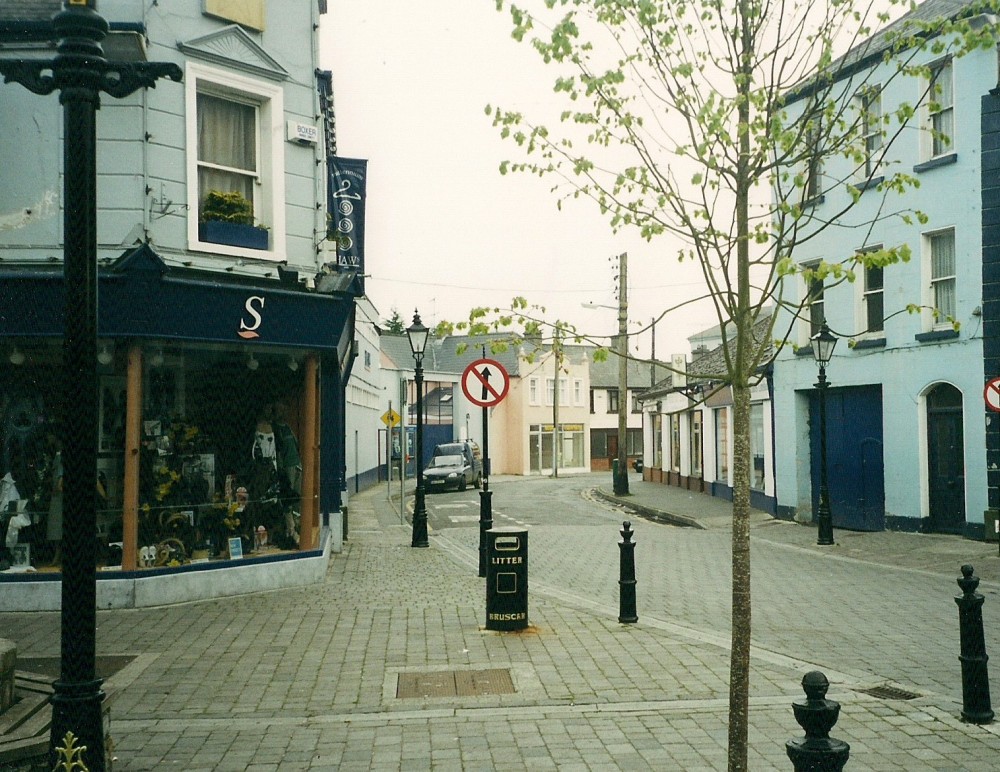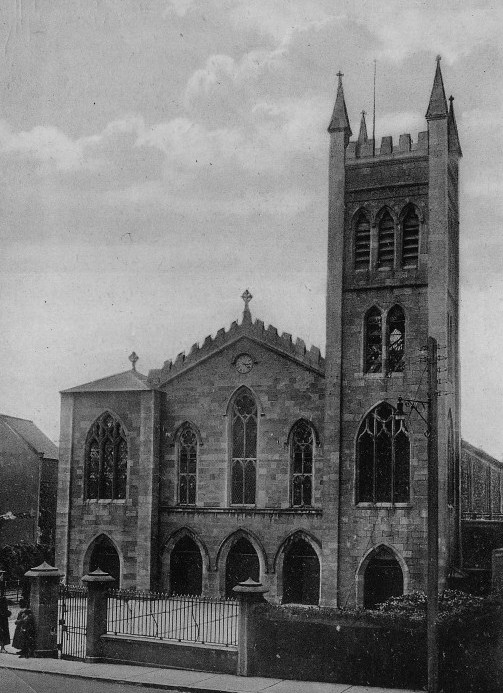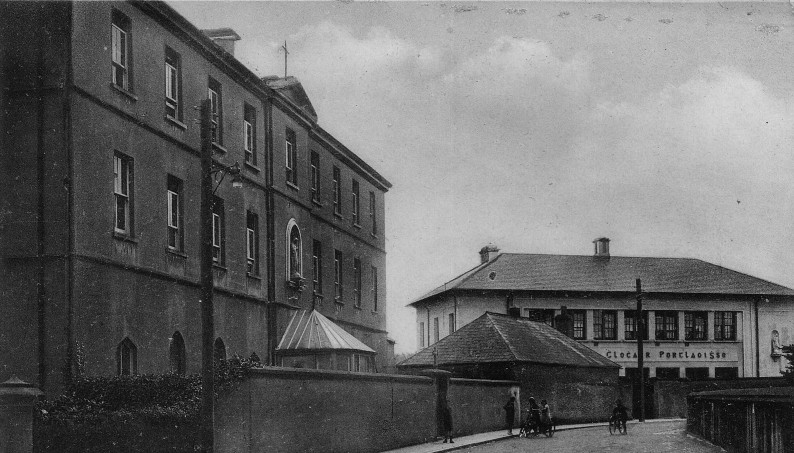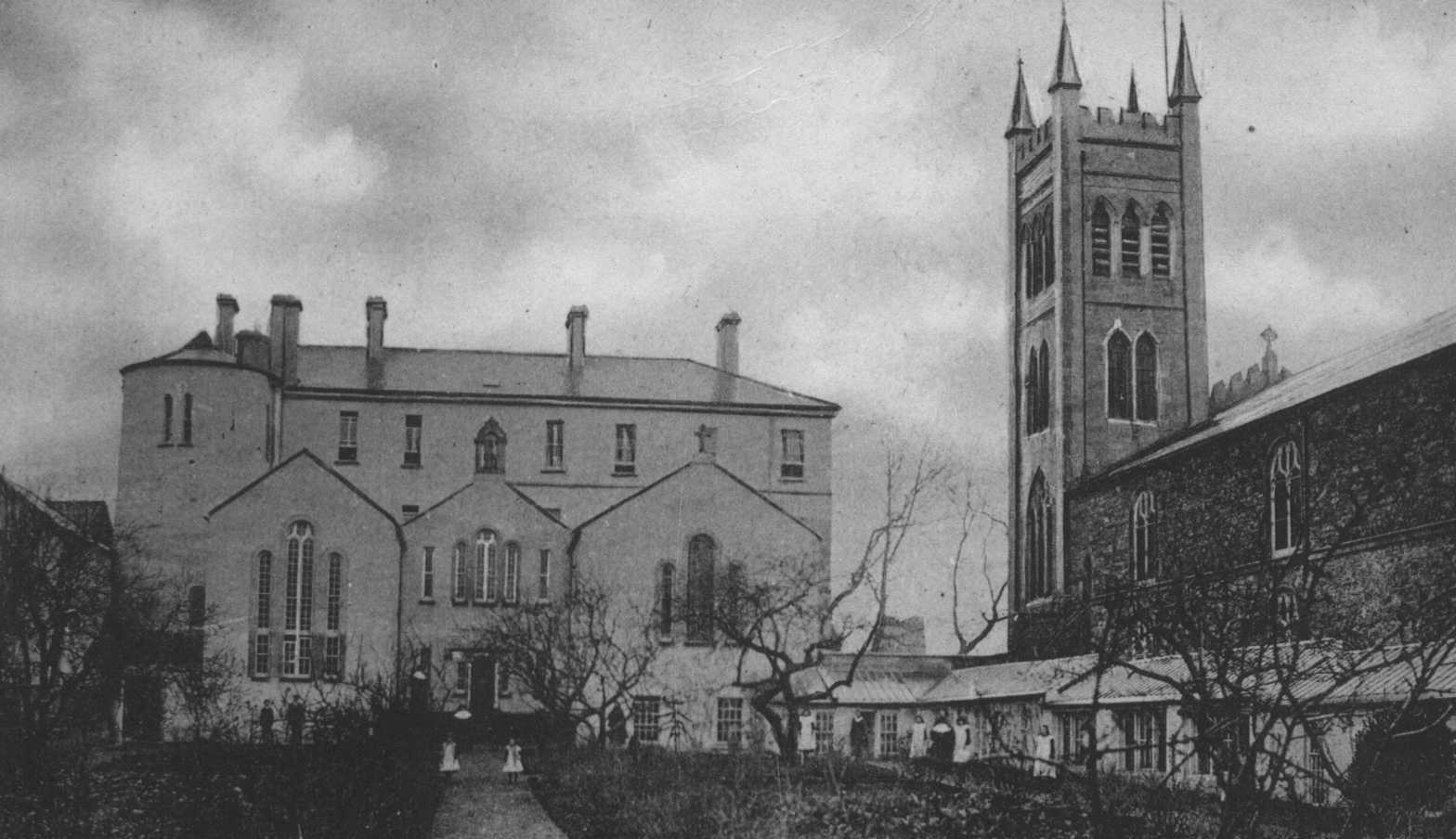
The old Catholic Church - usually referred to by earlier generations as 'the Chapel' - served parishoners from 1822. Over the years, many improvements and modifications were carried out: in October 1861, for instance, a pontifical high mass celebrated the blessing of a new bell and, twelve years later, an assessment of sixpence per acre was levied on parishoners to defray the cost of, inter alia, the extension of the gallery and flagging of the ground floor. There were three galleries in the church - the Front Gallery facing the altar, St Patrick's and Blessed Virgin Mary's on either side - and it's interesting to note that, up to the 1920's at least, you had to pay an annual rent for the privilege of sitting there and looking down on the hoi polloi. A Catholic Church? Yes. A Christian Church? Hardly. The four small spires, incidentally, - clearly visible in the picture below - were known to locals as The Four Awls. The last Mass ever said in SS. Peter & Paul's was at 11 am, Sunday, July 4, 1965, after which this fine edifice was closed, gradually vandalised and eventually demolished in August 1977. According to the town Architectural Survey, its demolition constituted "one of the most significant losses to the town core"1.


The Presentation Sisters came to Maryborough in 1824 and their first school was housed in the cellars of the recently-opened church. One of the earliest teachers was Hannah Gurley, a convert to Catholicism and grand-aunt of George Bernard Shaw (who we last encountered in Aird's Hotel). In those early years, the Sisters were badly affected by illness and disease. Cholera and typhus were common. In evidence before a Parliamentary Select Committee in 1832, Parish Priest of Maryborough, Fr. Nicholas O'Connor, stated that famine was rife in 1817, 1822 and 1825. People, he said, turned yellow from living on the yellow weeds that grew in corn and, when administering the Last Sacraments, he was obliged to pick straw from the skin of the dying. The convent premises (marked as 'Nunnery' on a map from 1832) incorporated the Stonehouse which, along with old St Peter's church tower in Railway Street, is today the oldest building in the town. Dating from the mid-16th century, the Stonehouse had various prior uses - constable's residence, infirmary and gaol - and today, despite almost two centuries of change and reconstruction, this circular tower is still clearly visible from the Ridge Road and the Burial Ridge (known locally as 'the Bernridge').


In June 1876, Edward Eagney, a travelling repairer of rosary beads, was accused of murdering Sister Mary de Sales Fitzpatrick inside the convent. This caused outrage in the town. As reported in The Irish Times, a large crowd gathered at the Courthouse and 'loud shouts of horror and hootings: Hang him! Let us at him! Tear him to pieces! were raised against the prisoner'. During his trial, Eagney maintained that God wanted nuns and he was on a mission to send them to Him. He was acquitted on the grounds of insanity and committed to the Criminal Lunatic Asylum in Dundrum. The last of the Presentation Sisters vacated the convent in 2000 and today, this fine building stands boarded up and semi-derelict, prey to what is euphemistically called anti-social behaviour. (In October 2013, the local paper reported that the Gardaí and Fire Services had to attend the premises). The Secondary school moved to a new purpose-built campus on the Borris Road in 2010, and today only the Primary classes - generations of Portlaoise people will remember the Ha'penny Babies just inside the front gate - remain where the nuns' story began almost two hundred years ago. In the middle of the 19th century, there were eight occupied residences in Chapel Lane. The other buildings were the corn mill (see my Odlum's Mill page), the church, convent and school, and the barrack of the Revenue Police. The latter were established in 1832 as armed escorts for the Customs & Excise in its efforts to suppress the manufacture of poitín. The force was disbanded in 1857 and its members absorbed into the Irish Constabulary (which eventually became the RIC). The building was later used as a grain store before being converted into accomodation for several families. An aerial view of this area taken during an Air Display in the 1940's shows the large three-story building where the convent pre-fabs are today. My informants remembered it by different names. Some called it 'the tenements', while others referred to it as 'the hauntings', (the latter probably coined by parents to keep children away from the empty building before it was eventually demolished). In 1901, there were fifteen families living in Chapel Lane and the convent was home to 23 nuns. A decade later, there were only ten families, while the number of religious had increased to twenty-nine.
All I know is a door into the dark.
Whenever I read those lines from Seamus Heaney's poem, The Forge, something stirs in the darkest corner of my memory, and I feel again the warmth of my mother's hand as she leads me from Ha'penny Babies, past Jimmy Conroy's forge, towards the Lower Square. Today, Jimmy Conroy's door into the dark is the blue gateway into what was, until 2013, Shaw's car park. His father, Edward, was also a blacksmith, and it's likely that he would have been at a 'numerously attended' meeting in the Town Hall in September 1872. There, blacksmiths from all over the county met 'to consider the position of the trade and the necessity of adopting a new scale of prices consequent on the increase in the prices of iron and coal'2. The upshot was that it would now cost four shillings a set to shoe a horse belonging to a gentleman or sportsman, three shillings if the owner was a farmer; and having an ass completely shod would set you back one shilling and eight pence. The building on the right of the top picture is the tallest structure in the Lower Square area. Enter its gateway in the 1960's and, on your left, you would have seen the workshop of undertakers Noel and Richard ('Atchelle') Rankin (For efficient service call or 'phone Portlaoise 254). A third Rankin brother, Des, was for many years sacristan of the parish church. Up the stairs on your left brought you into the workroom of tailor Jack Cleary whose nimble fingers did all sorts of alterations for Shaws. Into the right, behind Aird's (see the page after next), was a small dark shed housing a printing press owned by the late Padraig Moran who also worked in the ESB. For one teenage summer in conditions that were pure Dickensian, I was a printer's devil and learned to set type and work the Heidelberg printing press and guillotine. [Mr Moran later relocated the business to his residence on the Mountrath Road]. In the 1950's, this area also housed a Receiving Depot for Ivy Cleaners and Dyers, a dry cleaning company based in Nenagh, and chiefly memorable for its catchy advertising slogan: To be Envied Be Ivied. J. L. Bradshaw & Co. Ltd., (Motor Parts, Tools and Equipment) on the Stradbally Road today, also started here in 1951. The arched doorway led upstairs to Tom Aird's dental surgery where, in 1957, for instance, five fillings would have cost you £3/10/0 (Three pounds and ten shillings).
1 It's ironic that the remains of what is believed to be an earlier Mass House - built towards the end of Penal Times (1792) - are still standing just off Main Street, and it's hard to credit that the building was also once used as a slaughterhouse. The ecclesiastical gable is best viewed from the rear of what is today de Brun's public house. 2 As reported in The Irish Times of September 4, 1872. The meeting, incidentally, was chaired by Mr William Tynan of Stradbally. I wonder was he an ancestor of Din Tynan who, for many years within living memory, had his forge on the corner of the Mountrath Road and Tea Lane. |
 |
 |
| HOMEPAGE |